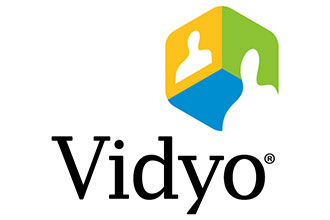Disruptive Forces in AV/IT – Part 5: Vidyo
 Here it is, the final chapter of a series that included highly worthy participants that exist in this new age of communications and collaboration. I decided to look up the term “disruptive forces” on Google and I came up with another term on Wikipedia – “disruptive innovation,” which is defined as an innovation that helps create a new market and value network that eventually disrupts an existing market and value network (over a few years or decades) displacing an earlier technology. The final company participating in the series may just be the company that created this particular pathway for others to follow in the industry.
Here it is, the final chapter of a series that included highly worthy participants that exist in this new age of communications and collaboration. I decided to look up the term “disruptive forces” on Google and I came up with another term on Wikipedia – “disruptive innovation,” which is defined as an innovation that helps create a new market and value network that eventually disrupts an existing market and value network (over a few years or decades) displacing an earlier technology. The final company participating in the series may just be the company that created this particular pathway for others to follow in the industry.
Vidyo, based in Hackensack, New Jersey, began in 2005 as a start-up, embarking on an effort that would eventually result in a paradigm shift for the video conferencing industry by creating a brand new system architecture. Its solution would be based upon Scalable Video Coding (SVC), allowing for error resiliency which was absent in encoding schemes that were, up until that time, common throughout the industry. At the end of 2007, Vidyo fully emerged on the scene offering a full annual licensing price model, essentially lowering the startup cost barrier for organizations looking to implement a video conferencing solution. Vidyo initially shipped its software pre-loaded on off-the-shelf servers as well, to provide solution continuity in the industry while promoting a whole new video conferencing infrastructure that today runs as virtual machines in VMware environments. Since 2007, Vidyo has introduced high-resolution desktop and mobile video, and the world’s first software-based platform for video communications and collaboration to leverage the H.264 SVC standard — developed in large part by members of the company’s early team.
My final blog participant is Mark Noble the vice president of Strategic Marketing for the company, responsible for the selection and development of strategic vertical markets through integrated marketing campaigns.
CM: Mark thank you for participating in this blog interview. Please tell us about the company and its culture.
MN: Vidyo is composed of a group of dedicated individuals who share a common vision — improve the way people work and live by overcoming the barriers of time and distance through ubiquitous access to video communication. We place a very high value on agility and the ability to move quickly to address customer needs. This is reflected in all groups throughout the organization from R&D to sales and marketing to customer support. As a company that drinks our own champagne, we use Vidyo on a daily business as a key business tool. We are spread throughout the world with many of our employees working from their home offices or splitting time between our corporate offices and their home offices, all connected by Vidyo. This approach makes every employee a tester of the product, all the way up to the CEO, and we all take time to provide feedback continuously to ensure that our products deliver great user experiences before they are released.
CM: Can you describe Vidyo’s approach to satisfying the communication and collaboration needs of the enterprise?
MN: Vidyo’s approach to satisfying the needs of the enterprise is holistic via the extensible VidyoWorks™ platform. VidyoConferencing™ is a complete suite of products for enterprise unified communication and collaboration that rides on top of the VidyoWorks™ platform. The same platform can be used to integrate video communication into the enterprise’s customer contact center using the VidyoWorks™ API, or the enterprise can design its own web portal contact center using Vidyo’s contact center reference design. Specific workflows can also be enabled using the same platform. For example, in healthcare, Vidyo is integrated with some of the largest electronic medical health records systems to facilitate physician-to-physician and physician-to-patient interactions directly from the workflow tool where all of the patient data lives and is readily accessed. There is no limit to what an enterprise can do with the VidyoWorks™ platform. We can video enable any application, web portal, kiosk or custom client. This becomes particularly important as you consider the need for humanization in the context of the Internet of Things.
CM: As noted here, Vidyo was the company that really started it all in this current mass market of disruptive technology solutions providers. Can you give us an in depth view of how Vidyo continues to build upon its video conference market strategy?
 MN: Vidyo continues to disrupt the market in a number of dimensions. First, we believe that the future of video communication and collaboration is one in which the communication appears where and when the user needs it – in other words, embedded into other applications as opposed to being its own standalone application like UC clients are today. The VidyoWorks platform was built from the ground up to embed video, audio and content, communication and collaboration into business processes, workflow applications and web portals with the industry’s most robust suite of APIs and SDKs. Vidyo customers are able to take advantage of multiple applications such as enterprise communication and collaboration, video enabled contact center, specific business process video enablement, among others, using the same infrastructure and platform. This ultimately means our customers see incredible value and exceptional ROI on their investment with Vidyo. Additionally, as a software platform, Vidyo continues to rapidly deliver new capabilities for our embedded customer base as software upgrades.
MN: Vidyo continues to disrupt the market in a number of dimensions. First, we believe that the future of video communication and collaboration is one in which the communication appears where and when the user needs it – in other words, embedded into other applications as opposed to being its own standalone application like UC clients are today. The VidyoWorks platform was built from the ground up to embed video, audio and content, communication and collaboration into business processes, workflow applications and web portals with the industry’s most robust suite of APIs and SDKs. Vidyo customers are able to take advantage of multiple applications such as enterprise communication and collaboration, video enabled contact center, specific business process video enablement, among others, using the same infrastructure and platform. This ultimately means our customers see incredible value and exceptional ROI on their investment with Vidyo. Additionally, as a software platform, Vidyo continues to rapidly deliver new capabilities for our embedded customer base as software upgrades.
The most recent example of this is the support for 4K Ultra HD (UHD) in both the Vidyo infrastructure and on our VidyoRoom™ HD-230 and VidyoPanorama™ 600 group system products as a software upgrade. For other vendors’ hardware-based solutions, the move to UHD represents obsolescence of deployed infrastructure and endpoints requiring costly rip and replace actions to gain the technology advancement. This is critically important for those making infrastructure decisions today, as the choices made now can limit the applications and capabilities that users will demand six months to a year from now. Proliferation of greater than HD devices like iPads and MacBook Pros with retina displays and 1440p all-in-one desktops, along with the rapidly falling prices of 4K displays in the consumer space is going to set a new bar of user expectation for video quality in real-time video interactions. This is exactly what we saw with demand for 1080p conferencing, as 1080p displays became common-place in people’s homes.
Another way Vidyo is disrupting the market is through a reinvention of the group system solution for the enterprise. An astonishing 95 percent of collaboration spaces in enterprises have not been video enabled due to cost and difficulty of use. Vidyo believes that in order to make video the new dial-tone, or primary mode of communication for people, that it must be ubiquitously available to users and brain dead simple to use. VidyoDesktop™, VidyoMobile™ and VidyoWeb™ have achieved this for user’s personal devices, but physical group collaboration spaces require some additional capabilities, like far end control of the in-room camera, simple remote control interfaces, and tight integration with professional camera and audio solutions. The recently announced VidyoRoom™ SE, which will be available globally before the end of July, is a software application installable on an enterprise’s general purpose computing platform that delivers advanced room system capability with up to 4K UHD performance at a price point that makes it affordable to outfit every collaboration space in an organization. Finally, UHD brings with it demand for more bandwidth. Vidyo has been instrumental in driving scalability into the next generation of codecs, H.265 and VP9, which deliver as good or better quality than their predecessor codecs at half the bandwidth. Vidyo is collaborating with Google to implement scalability in VP9 through our focus on WebRTC, and H.265 is scheduled to ratify with scalable extensions this summer. Both codecs will be natively routable through the Vidyo infrastructure via software upgrade in the future.
CM: Can you tell us about what you will be bringing to InfoComm this year?
MN: We’re going to have a great presence at this year’s show. We’ll be demonstrating new products, including UHD on our VidyoRoom™ HD-230 and VidyoRoom™ SE, and also showing the Universal Meeting concept that allows meeting participants to join conferences quickly and easily regardless of what technology the user has. Additionally, the VidyoWorks™ platform will be on display via our contact center reference design demonstration. And we will have an exhibit of some future technologies.
CM: Can you give us an idea of your overall strategic marketing approach?
MN: Our approach to strategic marketing is focused on identifying specific market segments where video communication enablement delivers remarkable business results. From there, we identify and work with key strategic partners in that market space to deliver solutions to market with greater value than the sum of the individual pieces.
CM: Any last words for your channel partners?
MN: The industry is changing rapidly from the big iron hardware of yesterday to software and cloud solutions today. Those who fail to embrace the change will go the way of the dodo. Going forward, those that have the vision to see the tremendous upside ahead of us with customized solutions through software platforms with APIs for simple development, will emerge as leaders in the industry. We are committed to helping our partners make this transition a success, by offering the best platform and tools that enable serious value generation for customers and significant revenues for our partners.
I would like to thank Mark Noble for being my participant in the final blog of this series. You can see more about Vidyo’s products, solutions and applications on its website. Not only did this blog series concept take off with some tremendous social media sharing, it was also an absolute pleasure to do as I’ve met participants from around the world, many of whom I will be catching up with at the show. There are certainly other disruptors out there and certain ones will be highlighted in my next series coming in September “The Next Wave of Disruptive Forces in AV/IT.”
One other observation before I close it out – for many months the industry has been labeling these game-changing technologies as “disruptive.” Well, in all fairness I believe that the long established industry companies need to inject a level of disruption into their technology focus as well, otherwise they may wake up looking in the rear view one day to see newer advanced solutions hitting the market like a flash, potentially grabbing their market share (and in certain cases, this is already taking place). Fall asleep at the switch and you may be watching your existence flash before your eyes. Disruption? It’s the technology injection that this industry has needed for years. Oh, and now add Microsoft to that mix as well.
Have a great time at InfoComm — and remember what happens in Vegas, well you know the story there…





